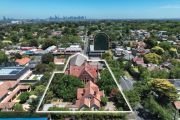
Infrastructure cranes hit record, housing slumps
The infrastructure boom pushed the total of non-residential cranes across the nation to a record 370, while slumping investment in new housing cut residential cranes to a two-year low in the latest real-world barometer of the country’s construction sector.
Net gains, including 11 more cranes on civil infrastructure work, an extra nine on civic projects such as libraries and a further five on data centres, failed to offset the net loss of 42 cranes on residential projects, pulling total cranes to 863 in the Q3 2024 RLB Crane Index report, from 869 six months ago.

The infrastructure boom – funding projects such as Victoria’s $36 billion North East Link – was keeping costs high and making it harder for private projects to stack up, said Domenic Schiafone, the head of Oceania research for quantity surveying firm RLB, which produced the report.
“There’s pressure on contractors to lock in subcontractors months before they’re on site,” Mr Schiafone told The Australian Financial Review.
“When you have [residential] projects that could get off the ground the pricing has not been feasible.”
The effect of sustained higher costs on housing development was clear on Wednesday in separate official figures that showed housing starts of apartments, townhouses and semidetached homes fell 6.7 per cent in the June quarter to 14,031, an 18-month low.
The quarterly slump in new commencements of so-called “other residential” outweighed the 1.9 per cent quarterly gain in detached houses to leave total starts down 1.1 per cent from March, the Australian Bureau of Statistics numbers showed.
RLB’s residential crane total fell to 493 from 535 six months ago.

Total housing starts for the year to June totalled 158,752, more than 81,000 homes short of the 240,000 run rate at which the country needs to be building to meet the government’s increasingly aspirational 1.2 million-home target over the five years to 2029.
“Detached house starts fell by 10.1 per cent, while higher-density commencements were down by 6 per cent,” Master Builders Australia chief economist Shane Garrett said.
“If building continues at this pace, we’ll be in for less than 800,000 new home starts over the next five years.”
A separate measure of homes completed in financial year 2024 came in at 176,131, which was 27 per cent, or 63,869 short of the required yearly total under the national cabinet plan.
The effect of infrastructure on costs is clear in the enterprise bargaining agreements between contractors and the CFMEU construction union.
The North East Link deploys 30 so-called crawler cranes – which can move on a site – and has more cranes than any other project in the country.
An agreement the Fair Work Commission approved last month between Victorian builder Hacer and the union specifies a site allowance starting at $10.75 an hour for a Hacer employee of any type on the road project creating 6.5 kilometres’ worth of tunnels.
That North East Link allowance is more than the per-hour $4.60 extra Hacer workers are paid on projects worth $115.6 million to $289.1 million, a more typical project for the builder.
Brisbane had the biggest net reduction in cranes, down 12 from the last count six months ago to 66 as tower cranes in civil, residential, health, mixed-use, education and aged care projects all reduced.
Sydney and Newcastle both suffered a net loss of three cranes, while Hobart and Sunshine Coast lost two. Melbourne, Adelaide and Darwin rose by two, Canberra by four, Central Coast NSW by five, and Perth and the Gold Coast by one.
Mr Schiafone said there had been signs over the past six to eight weeks that weakener residential and commercial pipelines of work were boosting competition between subcontractors.
“We’re hearing from contractors they’re getting great tendering from the subcontractor market,” he said. “Subcontractors can see the pipeline is diminishing. They want the work.”











